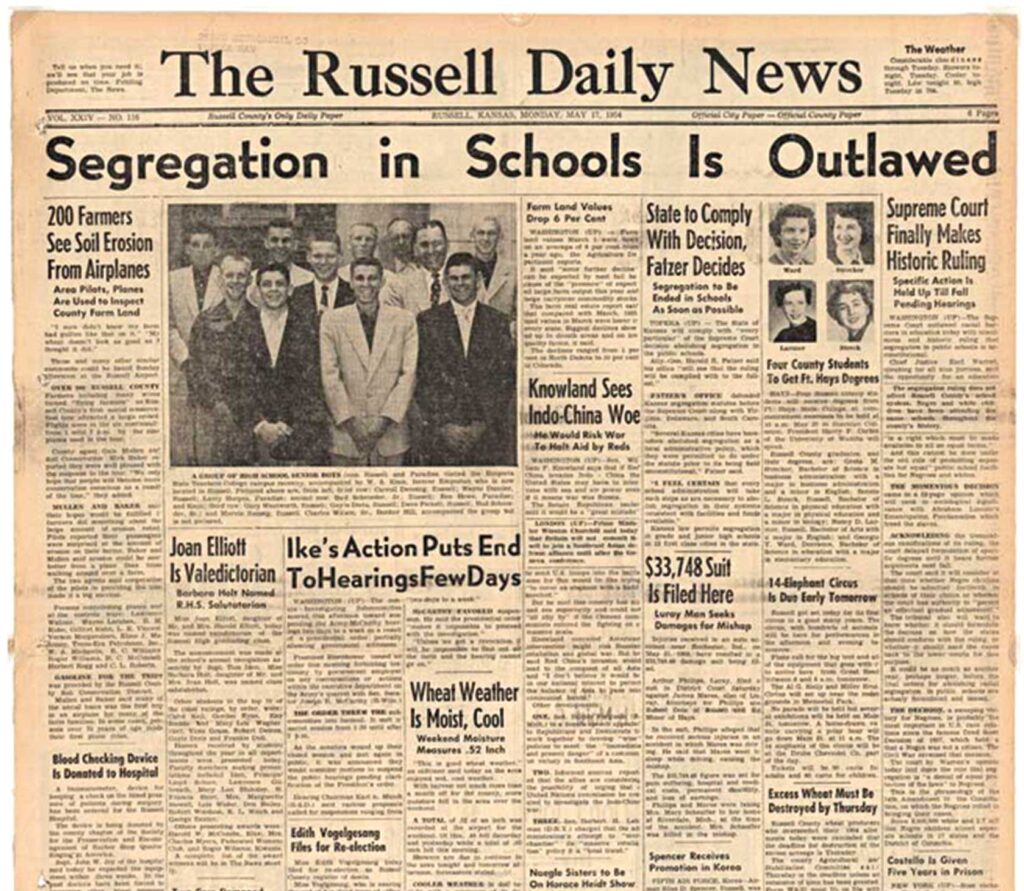
On May 17, 1954, the day the United States Supreme Court handed down its landmark Brown v. Board of Education of Topeka decision, three men stood outside the Supreme Court Building in Washington, D.C., hands joined together in solidarity.
A photograph shows the lawyers — George E.C. Hayes, Thurgood Marshall and James M. Nabrit — dressed smartly and smiling, below the words “Equal Justice Under Law” etched in marble above their heads.
They had much to celebrate. For years, Marshall and his peers had been fighting to end discriminatory laws in the U.S., specifically in schools, and that day they had won a major battle.
It has now been 70 years since the Brown v. Board decision, a ruling that outlawed segregation in schools. Shannon Frison, a retired Massachusetts judge, said it’s an apt time to celebrate the anniversary as a watershed victory that contrasts with recent setbacks like the striking down of affirmative action last June and the proliferation of book bans in recent years. These moves, she said, go against the principles of Brown v. Board.
“They’re moving in the wrong direction,” she said, adding that the current moment calls for reflecting on the time before the 1896 Plessy v. Ferguson decision enshrined the concept “separate but equal” in law and the Brown v. Board case that struck it down.
“We need to look back at that and learn from it again,” she said.
When the Supreme Court handed down the Brown v. Board ruling in 1954, the moment had been decades in the making.
“The Brown decision was justice delayed, too long denied, but finally realized after the Plessy v. Ferguson decision in 1896 that created a doctrine and legalized the practices of ‘separate but equal,’” said Michael Curry, former president of the NAACP Boston branch, in an email to the Banner.
In the years leading up to the 1954 decision, district and state courts heard arguments for at least four other major cases, all centered on a fight against racially discriminatory laws, starting most notably in the 1890s.
In 1890, Louisiana legislators had passed a law requiring passenger trains to partially or entirely divide their coaches to segregate travelers by race, according to the National Archives. Except for Black nurses caring for white children, passengers were required to abide by the law or risk a $25 fine or 20 days in jail.
On June 7, 1892, during a train ride to New Orleans, an African American man named Homer Adolph Plessy sat in the white compartment of the coach and was subsequently arrested and charged. When Plessy took the case all the way to the Supreme Court, arguing that the 1890 Louisiana law violated the U.S. Constitution, the court ruled against him and handed down the Plessy v. Ferguson decision in 1896, cementing the notion of “separate but equal.”
Seemingly undeterred, individual activists and groups forged ahead with their fight. After Plessy v. Ferguson, the legal branch of the NAACP undertook cases around discrimination in education, with Marshall becoming a key figure in the movement after taking the helm there in the late 1930s.
The NAACP and Marshall fought cases on behalf of law students who were denied admission into whites-only law schools, allocated meager resources or forced to eat alone — all on account of their race.
In the 1950s, the fight turned from higher education to public schools when the Supreme Court heard arguments in five different cases challenging the “separate but equal” doctrine. These cases, brought by parents in Topeka, Kansas, were grouped, thus leading to Brown v. Board and the subsequent illegalization of segregation.
“Following the case, the NAACP worked with local units across the country on implementation of desegregation,” said Tanisha Sullivan, president of the NAACP Boston Branch. “It is only fitting that we acknowledge that as we mark the 70th anniversary of Brown, we are marking the 50th anniversary of Morgan v. Hennigan, the case that led to the desegregation of Boston Public Schools.”
Sullivan called the Brown v. Board decision “a seminal civil rights case [that] continues to serve as a promise for what the American public education system can be for all students,” adding that it played a key role in the education advocacy work carried out by generations of civil rights leaders.
The 1954 decision was one of the most important civil rights moves equalizing access to education and a “major benefit” to people of color and to the United States, said Frison. She added that “the notion that somehow separate was going to be equal was never a reality, and so that decision pretty much alone changed the lives of all the generations to come so far.”
Despite the changes brought forth by Brown v. Board, Frison said, society has been “slow to keep up with all that it promised.” While the ruling did away with segregation in education, private school and higher education attendance rates have not reached equal levels for minority students.
For example, while the share of non-white undergraduate students enrolled in colleges increased by about 9 percentage points from 2011 to 2022, white students still made up the majority at 52%, according to data from the National Student Clearinghouse. In 2020, Black students made up just 14% of undergraduate college enrollments.
“The Brown decision was only one necessary step in delivering equality in education by addressing de jure segregation, giving Black students access to more educational opportunities,” said Curry. “However, the disinvestment, defunding, neglect and abandonment of public education across this country after [Brown v. Board] left Black students with, ironically, more access to bad options, inadequate resources and diminished buildings.”
The ruling, Curry added, failed to address other factors that led to “underachievement for Black students.” He cited poverty, housing insecurity, incarceration, health inequity and a lack of agency in school policy as factors that made for unequal education.
The Supreme Court’s 2023 decision to strike down affirmative action in higher education is a more recent threat to equality in education, both Curry and Frison said. Curry added that the decision and its implications are “far-reaching” and will likely lead to “more losses.”
“We have yet to achieve the quality education for all kids that was the ultimate goal” of Brown v. Board, he said.






